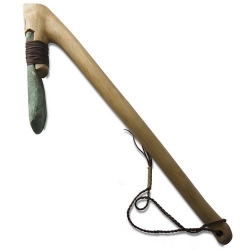Maori songs - Kiwi songs - Home
Raureka took Ngati Wairangi's greenstone axetechnology to the Ngai Tahu on the east coast.
|
Whaka-atu1 ra e taku toki |
|
I stretch forth my axe |
Raureka's alpine crossing
Accompanied by a slave, she wandered up into the
mountains at the head of Lake Kanieri, she discovered the
pass now known as Browning’s Pass. After climbing the
cliff at the end of the valley, she rossed the divide and
travelled down the Rakaia Valley into the plains of what
is now Canterbury. She then recited a song which was chanted when these axes
were used in timber-felling and other woodman’s work. Over time the Ngai Tahu went to war with Ngati Wairangi and wrested control of the resource from them. The West Coast section of Ngai Tahu (Poutini Ngi Tahu) supplied their eastern relations, and Kaiapoi became a focus of pounamu trading. Te Rauparaha invaded Kaiapoi in the 1830s to get the pounamu which carried such status. Toki When Turi arrived in the Aotea in the 15th century, he brought Awhiorangi, his great-grandfather's 450 mm x 150 mm tanged toki, chipped from the shell of a giant clam. This was the prototype of tanged toki in Aotearoa. (Awhiorangi was handed down to Turi's grandson who placed inside a hollow puketea tree at Moerangi, behind Okotuku Pa near today's Waverley, and the area was declared sacred. The old adze was located again in 1887, carefully described, and kept at Nukumaru until it disappeared again in 1937.) The greenstone was discovered by Ngati Wairangi who came from Poverty Bay to Blind Bay in Nelson. Finding the Waitaha Tribe already there they moved over to West Whanganui, and eventually occupied the whole of the West Coast. To work the greenstone, they had to learn a whole new technique. It could not be roughly shaped by chipping, and had to be sawn with sandstone knives. KauruThe sweet roots were either chewed at once, or else pounded, washed and squeezed to extract the sugar which was contained in great quantity, partially crystalised among the fibres of the root. The sugar was eaten as a relish with fern-root. Webpage put onto folksong.org.nz website Nov 2012 |